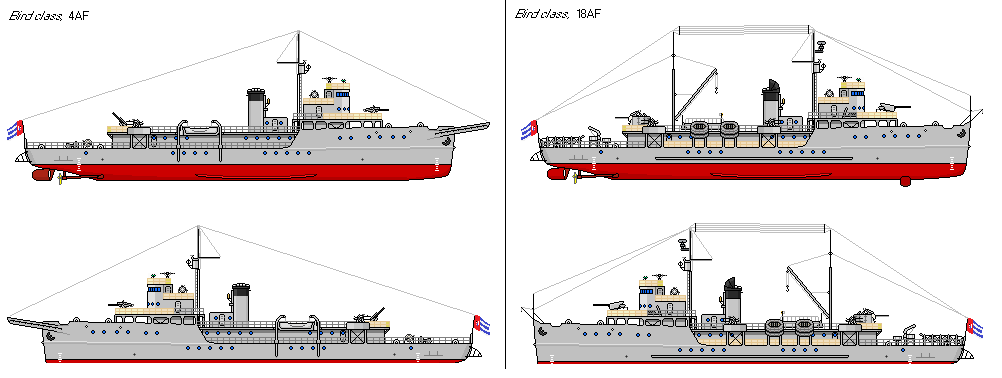HOME | DD
 CommodoreHorton — Seabird class sloop
CommodoreHorton — Seabird class sloop

Published: 2017-03-05 07:12:15 +0000 UTC; Views: 1267; Favourites: 23; Downloads: 14
Redirect to original
Description
Length: 204 feetDisplacement: 675 tons
Armament:
(as built) x2 75mm DP deck gun, x2 quadruple 20mm AA cannon.
(as refitted) x1 102mm deck gun, x1 twin 50mm AA gun, x4 quadruple 20mm AA guns, Pelikan anti-submarine mortar, depth charges.
Restricted by the Yengiist pacifist doctrines that guided the recently created GCK in its early days, the grecken was essentially restricted to constructing destroyers, submarines and coastal ships for the forseeable future, as the government of the first lord counsellor Crouunprinz Oscar uff de Uthen--or as he came to be known on account of his setting the GCK on the path for a slow scale transition towards socialism, Oscar de Revolutionary--considered capitol ships to be aggressive in nature and hardly appropriate for a nation which professed its strongest interest in avoiding conflicts to build. Accordingly, this lead to a remarkable focus on ships of these types, and of these types, the Seabird class represents a remarkably utilitarian ship.
While not nearly as glamorous as her frontline brethren, the Seabird class and other auxiliary vessels--tugs, repair ships, tenders and the like--are the unsung reliables of a fully effective navy. Without them, key pillars holding up the weight of tens of thousands of tons of naval engineering would be absent. While the grecken has traditionally minimized its role as a force projection element and instead focusing on the defensive aspects of a strong navy, they have invested carefully into a small and efficient range of auxiliary vessels to support their larger ships, and the humble Bird class sloops are fine examples of these under-appreciated vessels.
As built, the Seabird class sloops were intended predominantly for coastal operations, and specifically were designed to combine the role of net-tender and pilot ships for harbor operations. Twin booms protruding from the bow allow the Seabird class to manage the anti-submarine netting universally found around the entrance to naval ports, and these types of ships often doubled as point-defense anti-submarine platforms at naval anchorages. However, the grecken's emphasis was becoming more focused on anti-piracy operations and escort duties, as well as the plethora of support roles such as survey work, fisheries protection and search and rescue operations that the grecken additionally took on as it grew. Accordingly, refitted Seabird class sloops did away with the large booms used for net tending, and instead uprated their armament in accord with the navy's standards; the 75mm main gun was replaced with a single 102mm, and the type's anti-aircraft and anti-submarine capabilities were expanded, particularly via the inclusion of ASDIC equipment.
So necessary did the navy find these types of ships that the twenty Seabird class sloops built were the most produced class in the grecken until the construction of the Hund and Felis classes of sloops, which were themselves intended as a successor to the design.
SCK Albatross
(ship's history goes here)
SCK Gannet
(ship's history goes here)
SCK Pelikan
(ship's history goes here)
SCK Kormorant
(ship's history goes here)
SCK Heron
(ship's history goes here)
SCK Seahauuk
(ship's history goes here)
SCK Fulmar
(ship's history goes here)
SCK Gannet
(ship's history goes here)
SCK Murre
(ship's history goes here)
SCK Petrel
(ship's history goes here)
SCK Puffin
(ship's history goes here)
SCK Auk
(ship's history goes here)
SCK Tern
(ship's history goes here)
SCK Skua
(ship's history goes here)
SCK Penguin
(ship's history goes here)
SCK Gull
(ship's history goes here)
SCK Shearuuater
(ship's history goes here)
SCK Sandpiper
(ship's history goes here)
SCK Oystercatcher
(ship's history goes here)
SCK Plover
(ship's history goes here)
UPDATED 29 July '19--redrawn art, expanded class info
























